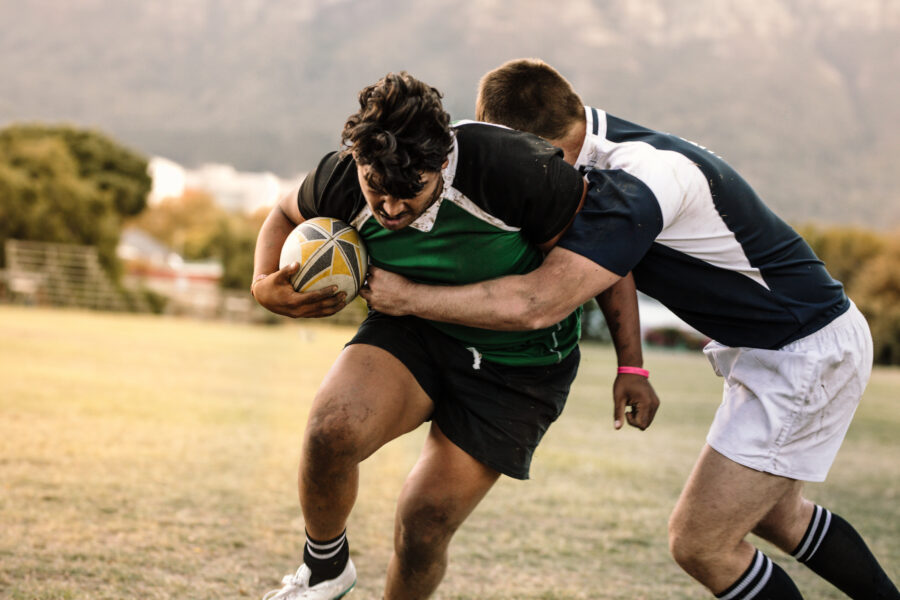
Group litigation orders for neurodegenerative injuries in sport: the state of play for provider
9 December 2024

Earlier this year, the first professional rugby union player was diagnosed with Chronic Traumatic Encephalopathy, or CTE, a neurodegenerative disease associated with repeated head trauma. This is the latest example in a string of recent news stories about former professional athletes, across an array of countries and sporting codes, being posthumously diagnosed with this condition. Many former athletes have taken to publicly platforming this issue, describing the various neurodegenerative diagnoses they have received since retiring from their chosen sport. Amid growing public awareness, scientific advancement and an increased pressure on sporting bodies to protect players’ welfare, debates have moved from the field to the legal arena for determination.
Since 2023, three Group Litigation Order (“GLO”) claims have been made in the High Court of England and Wales on behalf of football, rugby league and rugby union players against their respective governing sports bodies. This uptick in GLO claims is broadly consistent with a global trend of collective claims made by athletes for injuries incurred during their professional tenure. In 2015, the US National Football League (“NFL”) reached a class settlement with players to compensate those who developed dementia or other brain diseases associated with concussions. To date, the NFL has paid out $1.6bn to more than 1,600 former players and their families. Similar cases have also been brought in other sporting codes and jurisdictions.
Given the relative rarity of GLOs in the UK, there is significant uncertainty as to how UK courts will consider these claims. This article will first provide a general overview of GLOs, and then turn to doctrinal considerations and evidentiary hurdles faced by prospective claimants. Finally, this article will review the current position of insurers who operate in this area and identify strategies used to mitigate exposure to recognised risks.
GLO’S generally
A GLO is defined by the Civil Procedure Rules (“CPR”) as “an order made to provide for the case management of claims which give rise to common or related issues of fact or law (“the GLO issues”)”. It essentially allows multiple claimants with similar losses suffered due to the alleged wrongdoing of a shared defendant or defendants to have their claims heard as a group.
The legislative framework provided by the CPR is sufficiently malleable to allow the courts to manage the case around the particular legal and factual issues. However, while there is some flexibility around case management, courts have strictly defined what constitutes a “GLO issue”. In 2022, the High Court emphasised the need for GLO issues to be identified by claimants with sufficient specificity as a mandatory requirement of requesting such an order. This is because any GLO judgment or order made is binding on all parties. Courts will also turn their mind to whether there are enough members of a claimant group to support granting a GLO. These factors alone are barriers of entry for some claimants, but have not yet deterred those acting in the aforementioned sports injury cases.
GLO Rugby Union application
(A) Overview
In 2023, the High Court heard a GLO application involving claims brought by more than 350 former players (“the claimants”) against rugby union governing bodies World Rugby Limited, Welsh Rugby Union Limited and Rugby Union Football (“the defendants”). The application alleges claimants suffer from neurological injury as a result of head injuries incurred playing rugby. Lawyers for the claimants have stated that many of the players, “now suffer from various irreversible neurological impairments, including early onset dementia, CTE, post-concussion syndrome, epilepsy, Parkinson’s disease and motor neuron disease”. Similar claims are also being made against English and Welsh Rugby League and Football governing bodies.
Negligence on the part of the governing bodies is argued to have arisen in two ways. First, failure to adequately inform players of the risks of repeated concussive and sub-concussive injuries (pre-injury knowledge). Second, failure to protect players from such risks (post-injury protocol). On 1 December 2023, the High Court found it to be premature to make GLO order at this stage of the application. A GLO order remains available for the court’s consideration at further hearings scheduled for later this year.
(B) Doctrinal and evidentiary considerations
Limitations
As a general rule, personal injury claims must be made within three years of the date of the actual damage. However, if the claimant is not immediately aware of the injury, the three-year limitation period does not begin to accrue until the date of discovery of the injury.
The case of AB v Ministry of Defence illustrates this distinction. A group of military veterans brought a group action against the Ministry of Defence (“the Ministry”) for breach of duty for exposing the servicemen to radiation from experimental explosions carried out by the Ministry between 1952 and 1958, which the claimants alleged caused injury.
The question of when the claimants acquired knowledge of their injury came before the Supreme Court, who determined that “a Claimant is likely to have acquired knowledge of the facts specified in s 14 when he first came reasonably to believe them”. Reasonable belief is broken down by Lord Wilson to mean holding the belief with a degree of confidence, i.e., more than a suspicion, as well as a degree of substance rather than be the product of caprice. To re-contextualise this principle in present circumstances, it can be argued to mean it is the point at which someone with a neurodegenerative injury holds a reasonable belief that this injury is attributable to an act or omission of another party.
In addition to the provisions of sections 11 and 14, the Limitation Act also provides judges with a discretionary power to override the limitation period where justice requires it, as well as allows for an extension of the three-year period in cases of disability.
Duty of care
Duty of care owing to athletes is established in case law, however whether or not the duty extends to a sport’s governing body, remains a live question. In 2000, the High Court of Australia determined that no duty of care was owed by the International Rugby Football Board, now World Rugby, to certain amateur players who suffered spinal injuries in scrums. The claimants argued that IRFB’s failure to amend the rules to adequately protect players amounted to a breach of duty, however the court distinguished between an act and an omission. The court found that there were no positive acts done by IRFB which created a risk of injury.
This is consistent with the framing of duty of care in physical damage cases – whereby a line is drawn between causing harm – making things worse – and failing to confer a benefit – not making things better. Behaviour of a defendant which falls into the latter category, like in the case of Agar v Hyde, does not often attract a duty of care unless there are special circumstances.
A question arises as to how to appropriately categorise the action or inaction of a sport’s governing body. Is a governing body’s lack of updates to rules regulating head injury protocol a deliberate act or merely an omission?
There is speculation in recent jurisprudence that failure to protect a player could amount to a duty being imposed, particularly in circumstances where a defendant has assumed responsibility to a claimant. Following the reasoning in Watson v British Boxing Board of Control, some scholars argue rugby union governing bodies may have assumed responsibility to the claimants by creating and controlling the rules of the game which the claimant is subject to.
Breach
Even if a duty is shown to be owed by sports governing bodies to players, proving that a breach of duty has occurred is another hurdle. The law delineates between negligent acts and risks knowingly undertaken. It goes without saying that contact sports have inherent risks given the physical nature of the activity. In order for a breach to be made out, the governing bodies must be shown to have had failed to exercise an appropriate degree of care in relation to the potential risks of their sport. The difficulty is determining at which point a risk to the players becomes one which should have been foreseen and prevented by governing bodies.
Causation
Assuming for argument’s sake that a duty of care exists and has been breached, causation further complicates matters for claimants. A causal link between the alleged negligence of the governing bodies and the injury must be established. In other words, it must be found on the balance of probabilities that a claimant’s neurodegenerative injuries would not have arisen but for the negligence of the sport’s governing bodies. If there are question marks around the diagnoses being attributable to other factors, like age, genetics, comorbidities or life events, the chain of causation breaks.
There are specific challenges associated with those whose harm can be characterised as a neurodegenerative injury. The Washington Post recently investigated the NFL settlement and found that at least 14 players who failed to qualify for settlement money or medical care due to failing to meet diagnostic and/or causation requirements, were later confirmed to have CTE after death via autopsy. This exemplifies the issues unique to the injury being alleged. First, receiving a diagnosis of a neurodegenerative injury is a complex and protracted process – and can sometimes only occur once a person has died. Second, such a diagnosis is rarely attributed to a single cause due to the confluence of factors that potentially contribute to its existence. Both factors make it incredibly difficult to preserve a claimant’s chain of causation.
Insurance position
The recent increase in civil claims by athletes alleging failure to be properly informed or properly protected by their governing bodies from the dangers of neurodegenerative injury has made national and international headlines.
It follows that companies responsible for insuring these governing bodies, whether that be general insurance providers, specialised sports insurers or brokers negotiating on behalf of players, have legitimate concerns about the potential outcome of these claims.
Some providers have adopted proactive strategies to attempt to shield themselves from the potential ramifications of looming litigation, whereas others have moved away from providing insurance for this class altogether. The retrospective nature of these claims – the symptoms of neurodegenerative injury often occurring years after the athlete’s participation in the sport – creates a chasm of potential liability that cannot easily be closed by insurance companies. Nevertheless, mitigation strategies do exist which greatly lessen the potential exposure of sports bodies and their insurers to future claims, which are discussed below.
(a) Adoption of policy exclusions
Exclusion clauses are a well-established mechanism by which insurers restrict coverage for certain types of claims and losses. For a few years now, insurance providers to sports governing bodies have implemented specific exclusions relating to head or brain injuries. The specific wording of the exclusion clause, particularly in relation to neurodegenerative injuries, needs to be carefully crafted. As already established, diagnoses and definitions of neurodegenerative injuries are ever evolving. Chronic Traumatic Encephalopathy, or CTE, was once only known in the medical community, and has since cemented itself in the public lexicon; utilised by sports reporters and pundits alike. It is therefore essential that the terms which intend to exclude neurodegenerative injuries from coverage are properly defined by reference to current medical understanding.
Examples of Insurer’s policy exclusions regarding head injuries for athletes have been analysed in US courts. In Breland v Arena Football One LLC, the National Casualty CGL Policy issued to Arena Football contained the following exclusion: this insurance does not apply to damages for ‘brain injuries’ sustained by a ‘player’ arising out or in any way related to participation in any sports or athletic game, contest, event, exhibition or practice. The court acknowledged that “the exclusions and policy provisions of the GCL Policy may ultimately preclude plaintiff’s recovery” but determined that whether the players’ concussions were covered remained a live issue.
(b) Modification of limits
In addition to specific exclusions, there are other ways for providers to modify coverage to limit exposure. Policies can be written on a claims-made basis, which restricts coverage to claims that are reported during the currency of a particular policy. Policies written on this basis can present complexities in determining an appropriate retroactive date but do offer flexibility allowing a policyholder to review and adjust coverage limits and retroactive dates as the need may arise.
The claims-made method may be preferable to an occurrence-based approach – which covers incidents which take place within the policy period, regardless of when the claim is reported. Insurers working in the sports space are typically inclined towards the former, as it provides more security around timeframes, which is particularly relevant in circumstances where injuries can be discovered years after they were acquired
Insurance policies can stipulate aggregate limits to cap the maximum amount payable, which is particularly useful in a context where multiple claims can, have or will be made over the same issue. Given the number of potential members of GLOs for football, rugby league and rugby union actions, it can be logically inferred that multiple claims may arise from the same key issue – neurodegenerative injury. Finally, limiting clauses related to neurodegenerative injuries to the primary policy document, as opposed to extending to excess policy, controls the reach of possible claims.
(c) Proactive risk management
Beyond technical policy considerations, there is also a need for proactive risk management. Insurance companies should be carefully monitoring legal, medical and scientific developments in relation to neurodegenerative injuries, both generally and specifically in the context of athletes. The ability to evaluate the possible exposure of providers is predicated on an up-to-date knowledge of advancements in medical and judicial thinking.
Prior to providing coverage to a sports’ governing body, comprehensive analysis of their current risk management procedures should be carefully considered. Particular attention should be paid to their rules and regulations regarding player injuries – such as mandatory bans for unsafe tackles and post-match concussion assessments – compulsory health checks for players, and ongoing development of safety strategies. Doing this at the outset ensures that both the policy provider and holder have a mutual appreciation of existing risks and the extent their policy protects from such risks.
However, in order for such an audit to be effective, the insurer relies on the insured to provide an accurate representation of their protocols and practices. The duty of fair presentation legally requires an insured to disclose every material circumstance which the insured knows or ought to know, or failing that, to disclose sufficient information that would put a prudent insurer on notice to ask further questions. Insurers are provided with a range of remedies based on the nature of the breach. If the failure was deliberate or reckless, the insurer on risk may void the policy, refuse all claims, and retain the premiums paid. For inadvertent failures, the remedies will depend on what the insurer would have done had a fair presentation been made, such as adjusting terms or reducing claims.
Open and upfront communication between the insurance provider and holder should begin at the negotiation stage and continue for the duration of the relationship. If any circumstance arises which requires notification; a circumstance which the insured is aware of that may give rise to a claim, then the insurer should be told as a matter of priority. Most policies will have a notification of circumstance clause which stipulates the particularities of the notification, including its required form, content and timeframes. It is imperative that such clauses are followed to the letter to avoid any discrepancies between the insured and the insurer’s understanding of risk and the consequences that flow from any discrepancy.
Conclusion
Given the applications made on behalf of players against rugby union, rugby league and football governing bodies are ongoing, it remains unknown as to whether such cases will be heard as GLOs. Certainly, there appears to be enough claimants within these groups with shared GLO issues to justify an order being made. If an order is made, the claimants will have to contend with the doctrinal and evidentiary issues outlined here to achieve success. Claimants will have to overcome the initial hurdle imposed by limitation dates, and subsequently establish an unbroken chain of causation between the defendant’s act or omission and the injury suffered. As it currently stands, the ball is firmly in the judge’s court.
In the meantime, specialist brokers and insurers working in this area are continuing to proactively engage with sports’ governing bodies to enable ongoing protection and provide support for the continuation of grassroots sports in the face of looming litigation. Insurance providers can seek to mitigate future exposure by actively monitoring medical and legal advancements and amending clauses and coverage as needed, to ensure policies reflect our evolving understanding of neurodegenerative injury.










